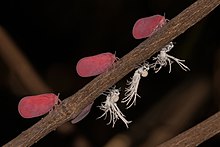Flatida rosea, the flower-spike bug or the flatid leaf bug, is a species of planthopper in the family Flatidae.[1] It is found in tropical dry forests in Madagascar, and the adult insects are gregarious, the groups orienting themselves in such a way that they resemble a flower spike.[2]
| Flatida rosea | |
|---|---|

| |
| Scientific classification | |
| Domain: | Eukaryota |
| Kingdom: | Animalia |
| Phylum: | Arthropoda |
| Class: | Insecta |
| Order: | Hemiptera |
| Suborder: | Auchenorrhyncha |
| Infraorder: | Fulgoromorpha |
| Family: | Flatidae |
| Genus: | Flatida |
| Species: | F. rosea
|
| Binomial name | |
| Flatida rosea | |
| Synonyms | |
| |
The adults have wide pink wings which they hold vertically in a tent-like fashion, concealing the whole body. The nymphs have no wings, but can move about, and are defensively covered in wispy white wax, with a plume of waxy tendrils. Like other bugs in this family, both adults and nymphs feed by piercing the bark with their mouthparts and sucking sap from the phloem. The adults are mobile and can jump if disturbed.[3]
Flatida rosea feed on the liana Elachyptera minimiflora. The nymphs produce copious quantities of honeydew and the Coquerel's coua (Coua coquerelii) feeds on this.[4]
References
edit- ^ FLOW
- ^ "Flower-spike / butterfly bug (Phromnia rosea) leaf hopper adults". Nature Picture Library. Retrieved 30 January 2021.
- ^ Jameson-Gould, Joseph (21 October 2011). "Flatid leaf bug: Phromnia rosea". Real Monstrosities. Retrieved 30 January 2021.
- ^ Schnitzer, Stefan; Bongers, Frans; Burnham, Robyn J.; Putz, Francis E. (2014). Ecology of Lianas. John Wiley & Sons. p. 367. ISBN 978-1-118-39249-2.
External links
edit- Media related to Flatida rosea at Wikimedia Commons